Unit 5 Meeting your ancestors warming up & reading
文档属性
| 名称 | Unit 5 Meeting your ancestors warming up & reading | 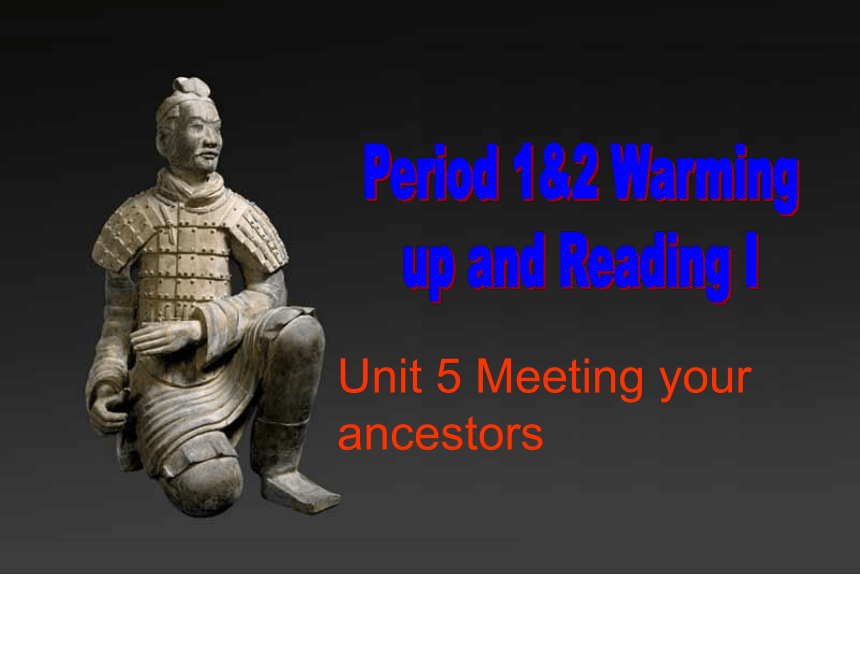 | |
| 格式 | rar | ||
| 文件大小 | 4.9MB | ||
| 资源类型 | 教案 | ||
| 版本资源 | 人教版(新课程标准) | ||
| 科目 | 英语 | ||
| 更新时间 | 2008-11-01 10:45:00 | ||
图片预览

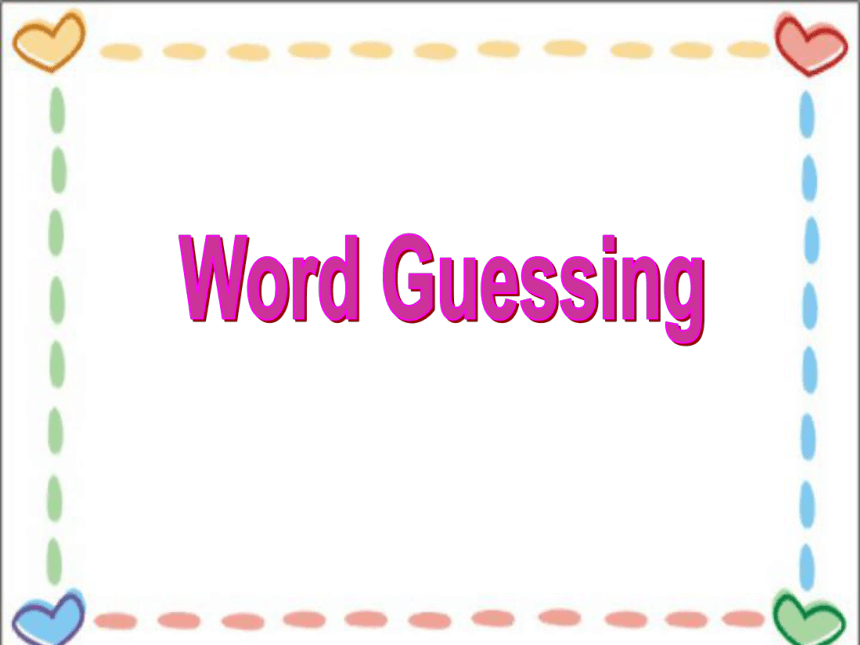
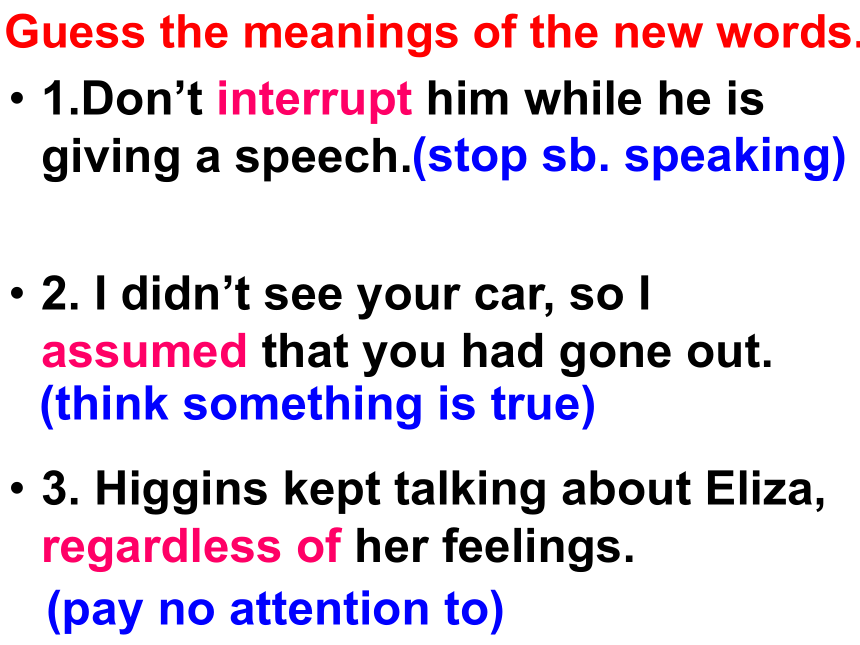
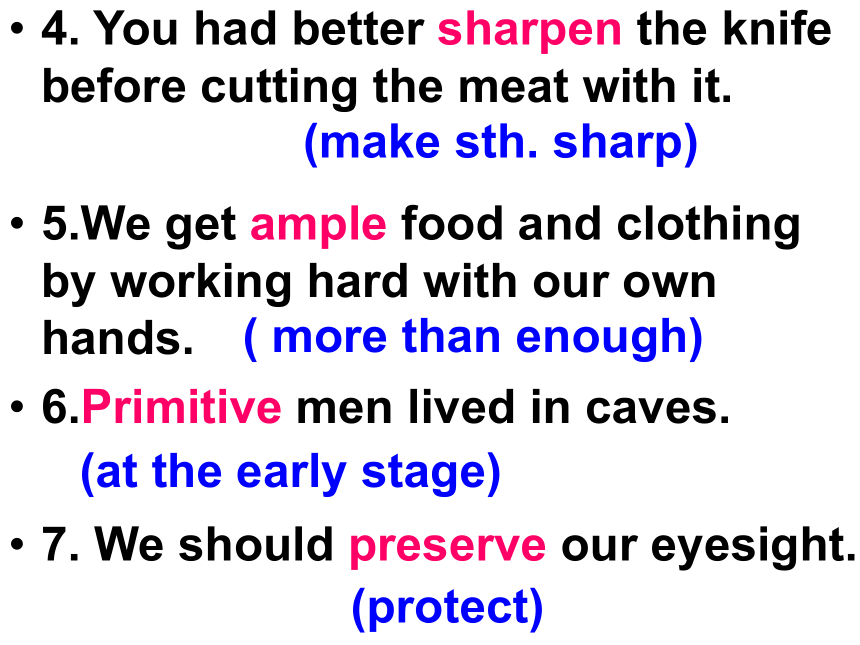
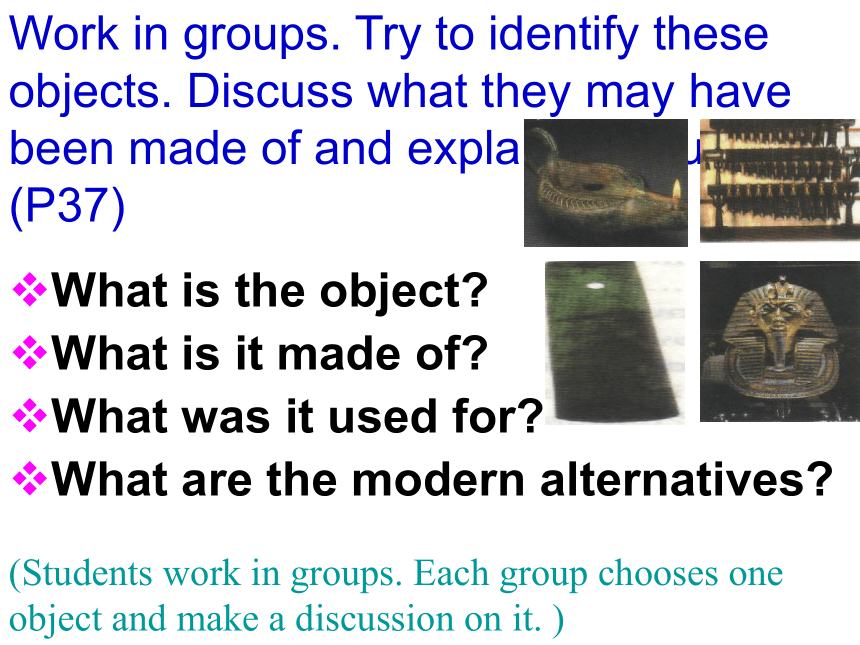
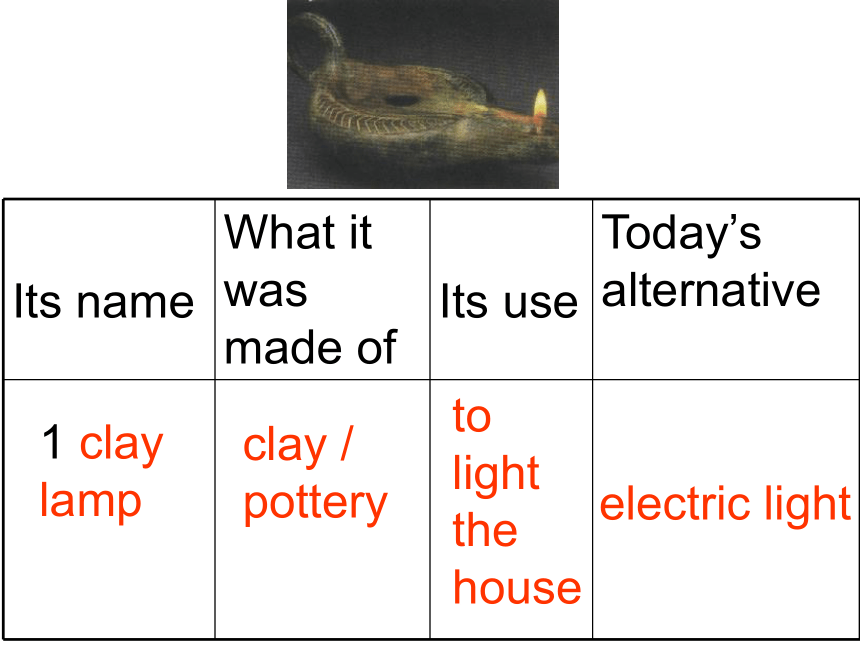
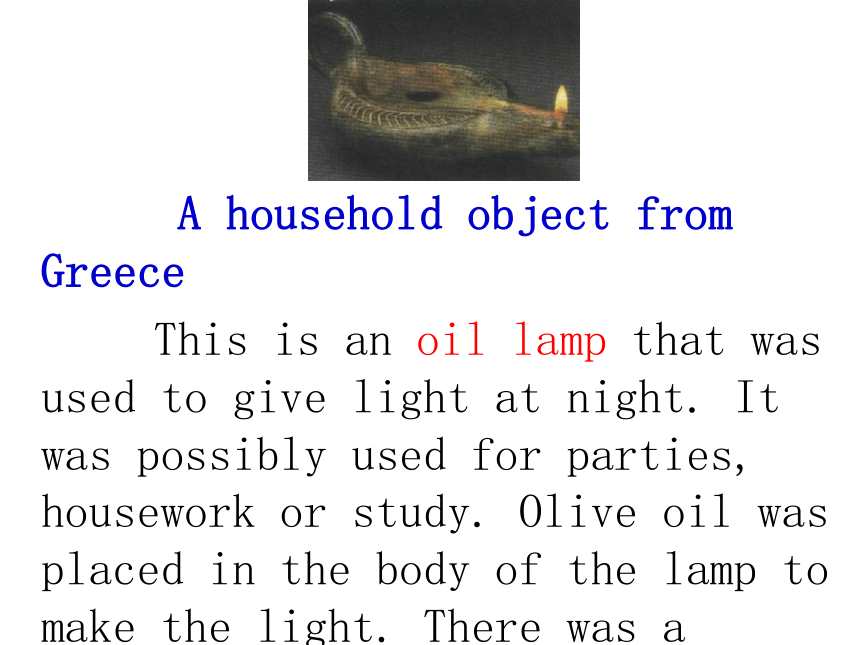
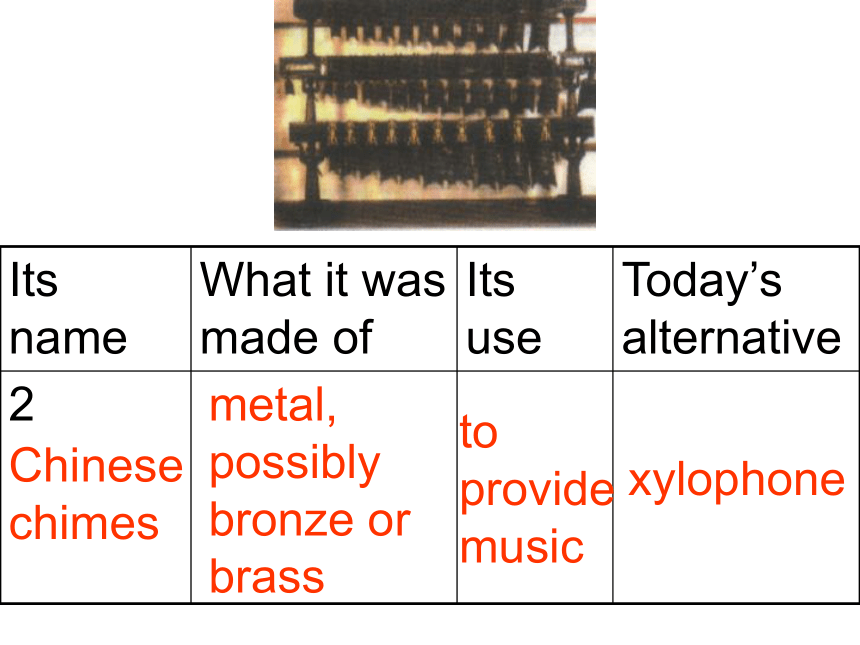
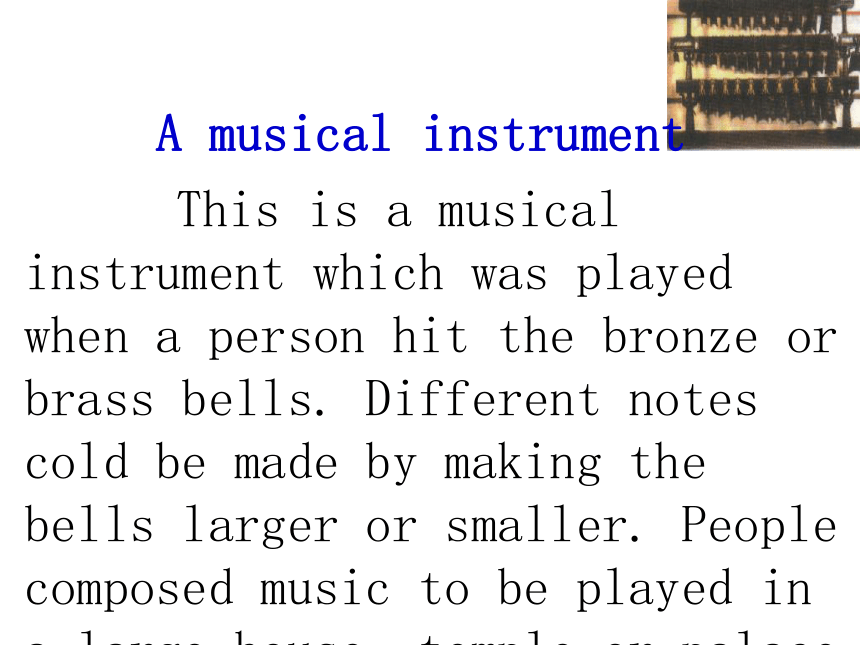
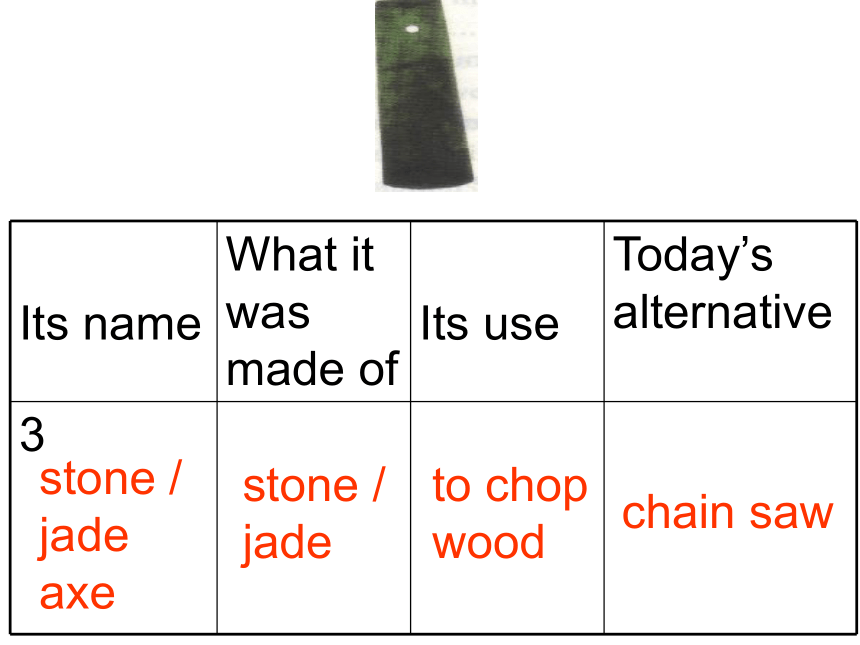
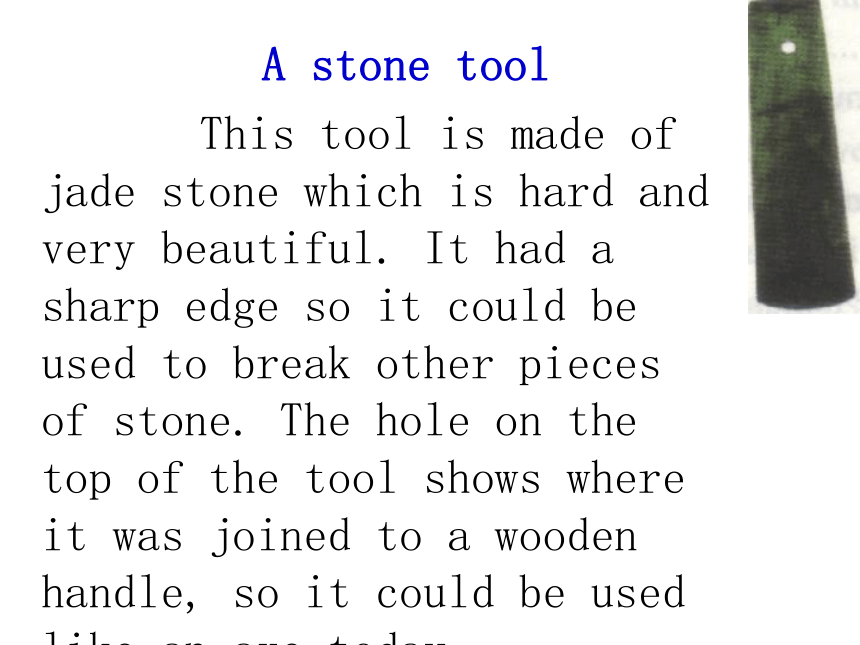
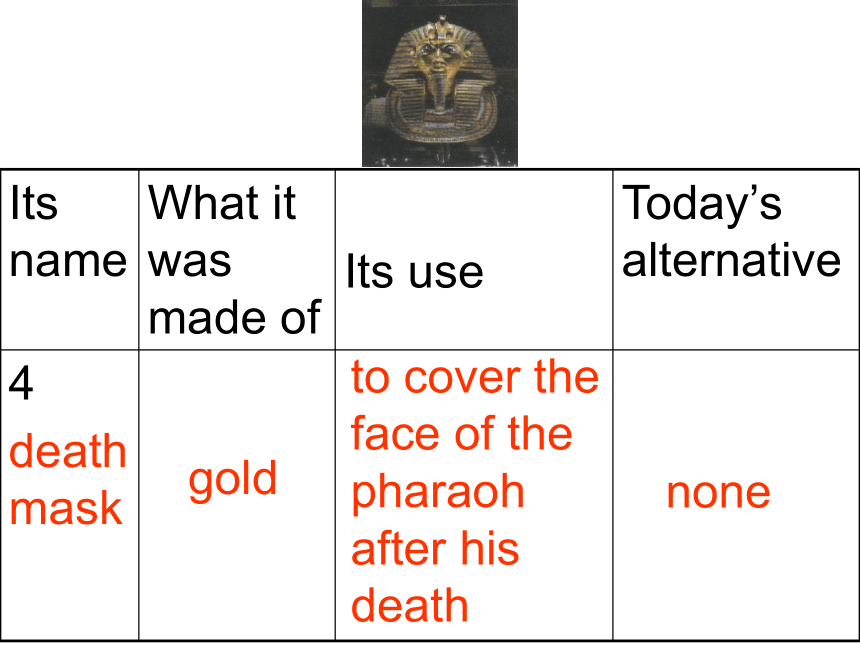
文档简介
课件46张PPT。Period 1&2 Warming
up and Reading IUnit 5 Meeting your ancestors Word GuessingGuess the meanings of the new words.1.Don’t interrupt him while he is giving a speech.
2. I didn’t see your car, so I assumed that you had gone out.
3. Higgins kept talking about Eliza, regardless of her feelings. (stop sb. speaking)(think something is true)(pay no attention to)
4. You had better sharpen the knife before cutting the meat with it.
5.We get ample food and clothing by working hard with our own hands.
6.Primitive men lived in caves.
7. We should preserve our eyesight. (make sth. sharp)( more than enough)(at the early stage)(protect)What is the object?
What is it made of?
What was it used for?
What are the modern alternatives?Work in groups. Try to identify these objects. Discuss what they may have been made of and explain their use. (P37)(Students work in groups. Each group chooses one object and make a discussion on it. )1 clay lamp
clay / pottery
to light the house
electric light A household object from Greece
This is an oil lamp that was used to give light at night. It was possibly used for parties, housework or study. Olive oil was placed in the body of the lamp to make the light. There was a thread that went from inside the lamp, and when it was lit it provided light.Chinese chimes
metal, possibly bronze or brass
to provide musicxylophone
A musical instrument
This is a musical instrument which was played when a person hit the bronze or brass bells. Different notes cold be made by making the bells larger or smaller. People composed music to be played in a large house, temple or palace.
stone / jade axestone / jade
to chop woodchain saw A stone tool
This tool is made of jade stone which is hard and very beautiful. It had a sharp edge so it could be used to break other pieces of stone. The hole on the top of the tool shows where it was joined to a wooden handle, so it could be used like an axe today.death maskgoldto cover the face of the pharaoh after his death none A face of an Egyptian Pharaoh
This is a mask which was placed over the Pharaoh’s face after he died. Sometimes they were also buried with the dead pharaoh. They were made of gold and decorated in beautiful colors. It shows that the Pharaoh expected his objects to have the best of material and workmanship.北京人头盖骨化石北京猿人复原图
Zhoukoudian CavesDo you know about Zhoukou Dian?
Where is it? What is famous for?It is on the Longgu Mountain, Fangshan District, Beijing. It is famous for Peking Man, a complete skull (头盖骨) of an ape-man(猿人) dating back 600,000 years. Work in pairs and discuss the following five aspects between Modern people and Peking Man.
Archaeologists study early people by examining the objects they used. Think about what we do and use nowadays, then try a tentative guess about what Peking Man might have done and used thousands of years ago.(Students work in pairs to discuss and fill in the chart. After 3 minutes, ask five pairs to report the five aspects.)stone, wooden or brick housecavewooden, special for each rooma fireplacesport, films, hobbies, education, job, TV meals togetherfruit, vegetables, meat and fish, etcmeat, fish, berries and fruit in season
natural and man-made fibresskins,
leavesA Visit to the Zhoukoudian Caves.Stage 1 :
Stage 2:
Stage 3: Skim the passage and write down the three stages of the archaeologist’s part of the dialogue. Life in the cave What can we learn from the needle What can we learn from the necklaceTask 1Glance through the text and answer these questions.Skimming 1. How did they keep warm?
2. What animals were their most dangerous enemies?
3. How did they make clothes?
4. What can we learn from the necklace they wore? 1. How did they keep warm?
They constructed the fires in the center of the caves to keep them warm. They might have kept fires burning all winter. They hung animal skins at the cave mouth to keep out the cold.
2. What animals were their most dangerous enemies?
Tigers and bears were their most dangerous enemies.3. How did they make clothes? Their clothes were made from animal _____.They used __________stone tools to ___ __the animals and _______ their skin. Then smaller _______were used to clean the fat and meat from them. They had to ____an ample amount of salt inside the skin to make it _____enough.
Finally, they would have cut it andskinssharpenedscrapersrubcut upremovesoft______the pieces together with _______ made of animal bones.sewnneedles4.What can we learn about the necklace
they wore? Some of the necklace beads were made of animal _______ but some were made of ______, which tell us that all the fields around here used to be part of a large shallow lake. Perhaps there was _____ between early people or they traveled
to the seaside on their journeys.bonesshellstrade5. What did the earliest people use fire for?
They used fire to keep them warm, cook the food and scare the animals.
6. What’s the main idea of the text?
A brief introduction of the life and habits of the earliest people in Zhoukoudian.7. Which of the following shows us the earliest people and the modern people have something in common?
A. People hung animal skins to keep out the cold
B. People never grew their own crops
C. People use science
D. People care about their appearance8. What can we infer from the sentences--- “This one looks very like a fish bone. Is it reasonable? ---Yes indeed, as the botanical analyses have been specifically showing us, all the fields around here used to be part of a large shallow lake. Undoubtedly there were fish swimming in it.”?
A. Being an archaeologist needs a wide range of knowledge.
B. A lake is not the sea.
C. People can identify the fish by the colour.
D. A fish bone can be made into a necklace.Life in the caveWhat we can learn from a needleWhat we can learn from a necklace Task 2Scanning Tell the 3 stages of the archaeologist’s part of the dialogue.Peking man lived in Zhoukoudian Caves, perhaps with animal skins to keep out the coldThey used needles, sharpened stone tools and small scraper.They wore clothes from animal skins and they also wore the necklace of animal teeth or shells.Task 3Listen to the tape and fill in the chartGo back and fill in the chart on the life and habits of Peking Man again. Compare it with the list you made for the Pre-reading. What differences are there?Task 4Stone, wooden or brick house. CaveVery accurateBeautiful furniture with lots of ornaments mostly made of wood or other special materials.Natural furniture made of stone or wood. AccurateWatching TV, surfing the Internet and traveling. Enjoy the nature or family get-together. InaccurateFruit, vegetables, meat and fish, etc. Natural food, such as nuts and fruits. AccurateNatural and man-made fibres. Clothes made from animal skins, leaves Accurate Do you think it is important for us to know about Zhoukoudian caves? Why?
Zhoukoudian Caves were formally inscribed (记入) on the “World Heritage List” in December 1987 at the eleventh session of UNESCO World Heritage Committee. The inscriptionSummary Task 5 of the Peking Man Site on the World Heritage List confirms the exceptional and universal value of the cultural site, which requires protection for the benefit of all humanity. The site is therefore not only of China, but also of the world as a whole.Read stage 2 and 3 carefully and find out the information about needle and necklace. Then make your own guess of what can be discovered from it.clothesmethods Tools cut
cleanworeappearanceanimal bonescut upseashells caught
ate nearby travelled tradedBeing polite:
You must be aware that…
I’m sorry to interrupt you but.. Ways to explain things:
We think it is reasonable to assume…
We think they might…
We have been excavating… We have been finding…
It seems…
Our evidence suggests…
As the botanical analyses have been specially showing us…
Perhaps…Useful sentence pattern 1) Go over the text.
2) Write a brief introduction to the Zhoukoudian Caves.
3) Find out the useful words and expressions in the dialogue.Homework
up and Reading IUnit 5 Meeting your ancestors Word GuessingGuess the meanings of the new words.1.Don’t interrupt him while he is giving a speech.
2. I didn’t see your car, so I assumed that you had gone out.
3. Higgins kept talking about Eliza, regardless of her feelings. (stop sb. speaking)(think something is true)(pay no attention to)
4. You had better sharpen the knife before cutting the meat with it.
5.We get ample food and clothing by working hard with our own hands.
6.Primitive men lived in caves.
7. We should preserve our eyesight. (make sth. sharp)( more than enough)(at the early stage)(protect)What is the object?
What is it made of?
What was it used for?
What are the modern alternatives?Work in groups. Try to identify these objects. Discuss what they may have been made of and explain their use. (P37)(Students work in groups. Each group chooses one object and make a discussion on it. )1 clay lamp
clay / pottery
to light the house
electric light A household object from Greece
This is an oil lamp that was used to give light at night. It was possibly used for parties, housework or study. Olive oil was placed in the body of the lamp to make the light. There was a thread that went from inside the lamp, and when it was lit it provided light.Chinese chimes
metal, possibly bronze or brass
to provide musicxylophone
A musical instrument
This is a musical instrument which was played when a person hit the bronze or brass bells. Different notes cold be made by making the bells larger or smaller. People composed music to be played in a large house, temple or palace.
stone / jade axestone / jade
to chop woodchain saw A stone tool
This tool is made of jade stone which is hard and very beautiful. It had a sharp edge so it could be used to break other pieces of stone. The hole on the top of the tool shows where it was joined to a wooden handle, so it could be used like an axe today.death maskgoldto cover the face of the pharaoh after his death none A face of an Egyptian Pharaoh
This is a mask which was placed over the Pharaoh’s face after he died. Sometimes they were also buried with the dead pharaoh. They were made of gold and decorated in beautiful colors. It shows that the Pharaoh expected his objects to have the best of material and workmanship.北京人头盖骨化石北京猿人复原图
Zhoukoudian CavesDo you know about Zhoukou Dian?
Where is it? What is famous for?It is on the Longgu Mountain, Fangshan District, Beijing. It is famous for Peking Man, a complete skull (头盖骨) of an ape-man(猿人) dating back 600,000 years. Work in pairs and discuss the following five aspects between Modern people and Peking Man.
Archaeologists study early people by examining the objects they used. Think about what we do and use nowadays, then try a tentative guess about what Peking Man might have done and used thousands of years ago.(Students work in pairs to discuss and fill in the chart. After 3 minutes, ask five pairs to report the five aspects.)stone, wooden or brick housecavewooden, special for each rooma fireplacesport, films, hobbies, education, job, TV meals togetherfruit, vegetables, meat and fish, etcmeat, fish, berries and fruit in season
natural and man-made fibresskins,
leavesA Visit to the Zhoukoudian Caves.Stage 1 :
Stage 2:
Stage 3: Skim the passage and write down the three stages of the archaeologist’s part of the dialogue. Life in the cave What can we learn from the needle What can we learn from the necklaceTask 1Glance through the text and answer these questions.Skimming 1. How did they keep warm?
2. What animals were their most dangerous enemies?
3. How did they make clothes?
4. What can we learn from the necklace they wore? 1. How did they keep warm?
They constructed the fires in the center of the caves to keep them warm. They might have kept fires burning all winter. They hung animal skins at the cave mouth to keep out the cold.
2. What animals were their most dangerous enemies?
Tigers and bears were their most dangerous enemies.3. How did they make clothes? Their clothes were made from animal _____.They used __________stone tools to ___ __the animals and _______ their skin. Then smaller _______were used to clean the fat and meat from them. They had to ____an ample amount of salt inside the skin to make it _____enough.
Finally, they would have cut it andskinssharpenedscrapersrubcut upremovesoft______the pieces together with _______ made of animal bones.sewnneedles4.What can we learn about the necklace
they wore? Some of the necklace beads were made of animal _______ but some were made of ______, which tell us that all the fields around here used to be part of a large shallow lake. Perhaps there was _____ between early people or they traveled
to the seaside on their journeys.bonesshellstrade5. What did the earliest people use fire for?
They used fire to keep them warm, cook the food and scare the animals.
6. What’s the main idea of the text?
A brief introduction of the life and habits of the earliest people in Zhoukoudian.7. Which of the following shows us the earliest people and the modern people have something in common?
A. People hung animal skins to keep out the cold
B. People never grew their own crops
C. People use science
D. People care about their appearance8. What can we infer from the sentences--- “This one looks very like a fish bone. Is it reasonable? ---Yes indeed, as the botanical analyses have been specifically showing us, all the fields around here used to be part of a large shallow lake. Undoubtedly there were fish swimming in it.”?
A. Being an archaeologist needs a wide range of knowledge.
B. A lake is not the sea.
C. People can identify the fish by the colour.
D. A fish bone can be made into a necklace.Life in the caveWhat we can learn from a needleWhat we can learn from a necklace Task 2Scanning Tell the 3 stages of the archaeologist’s part of the dialogue.Peking man lived in Zhoukoudian Caves, perhaps with animal skins to keep out the coldThey used needles, sharpened stone tools and small scraper.They wore clothes from animal skins and they also wore the necklace of animal teeth or shells.Task 3Listen to the tape and fill in the chartGo back and fill in the chart on the life and habits of Peking Man again. Compare it with the list you made for the Pre-reading. What differences are there?Task 4Stone, wooden or brick house. CaveVery accurateBeautiful furniture with lots of ornaments mostly made of wood or other special materials.Natural furniture made of stone or wood. AccurateWatching TV, surfing the Internet and traveling. Enjoy the nature or family get-together. InaccurateFruit, vegetables, meat and fish, etc. Natural food, such as nuts and fruits. AccurateNatural and man-made fibres. Clothes made from animal skins, leaves Accurate Do you think it is important for us to know about Zhoukoudian caves? Why?
Zhoukoudian Caves were formally inscribed (记入) on the “World Heritage List” in December 1987 at the eleventh session of UNESCO World Heritage Committee. The inscriptionSummary Task 5 of the Peking Man Site on the World Heritage List confirms the exceptional and universal value of the cultural site, which requires protection for the benefit of all humanity. The site is therefore not only of China, but also of the world as a whole.Read stage 2 and 3 carefully and find out the information about needle and necklace. Then make your own guess of what can be discovered from it.clothesmethods Tools cut
cleanworeappearanceanimal bonescut upseashells caught
ate nearby travelled tradedBeing polite:
You must be aware that…
I’m sorry to interrupt you but.. Ways to explain things:
We think it is reasonable to assume…
We think they might…
We have been excavating… We have been finding…
It seems…
Our evidence suggests…
As the botanical analyses have been specially showing us…
Perhaps…Useful sentence pattern 1) Go over the text.
2) Write a brief introduction to the Zhoukoudian Caves.
3) Find out the useful words and expressions in the dialogue.Homework
